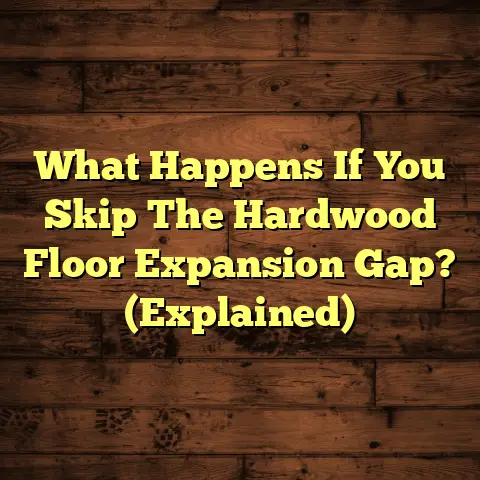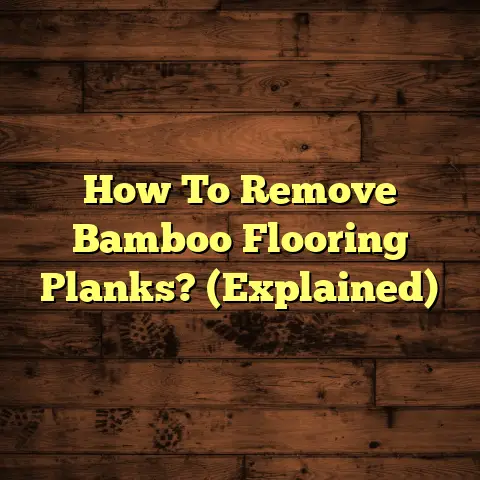Buff Hardwood By Hand? (4 Pro Tips!)
Did you know that with proper care,
a hardwood floor can last over a century?
It’s true!
I’ve seen it firsthand.
But here’s the kicker: many homeowners completely overlook a simple maintenance step that can drastically improve the floor’s appearance and lifespan – buffing.
Think of it as a spa day for your floors.
Ready to learn how to give your hardwood
that red-carpet treatment?
Let’s dive in!
1. Understanding the Importance of
Buffing Hardwood Floors
Okay, let’s get down to brass tacks. What exactly is buffing?
Simply put, buffing is a process of gently polishing the surface of your hardwood floor to restore its shine and remove minor imperfections.
It’s not the same as sanding or refinishing.
Sanding is aggressive, taking off layers
of the wood.
Refinishing involves sanding
and then applying a new finish.
Buffing, on the other hand, is more like
a gentle exfoliation.
It’s a surface-level
treatment that revitalizes the existing
finish.
I often tell my clients, sanding
is a major surgery but buffing is like
a regular check-up.
Benefits of Buffing
Why bother buffing? Here’s why:
Restores Shine: Over time, foot traffic and everyday wear can dull the finish of your hardwood floors.
Buffing brings back that luster, making your floors look like new again.Removes Minor Scratches: Those tiny scratches and scuffs that seem to multiply overnight?
Buffing can minimize or even eliminate them.Prepares for Finish/Polish: Buffing creates a smooth, clean surface that’s ideal for applying a fresh coat of finish or polish.
This helps the new layer adhere better and last longer.Prolongs Floor Life: Regular buffing prevents the buildup of dirt and grime, which can damage the finish over time.
By maintaining the finish, you’re protecting the wood underneath and extending the life of your floors.
Think of it this way: a well-maintained
floor isn’t just beautiful; it’s also
a smart investment.
A study by the
National Wood Flooring Association (NWFA)
found that homes with hardwood floors
often have higher resale values.
I’ve seen homes where a simple buffing job has made a huge difference in the overall appeal and perceived value.
2. Pro Tip #1: Choose the Right
Buffing Equipment
Alright, let’s talk tools.
You’ve got a few options when it comes
to buffing hardwood floors.
Rotary Buffers: These are the big machines you often see professionals using.
They’re powerful and efficient, but can be tricky to handle, especially for a beginner.
They can easily damage the floor if you are not careful.Floor Polishers: Similar to rotary buffers, but generally lighter and easier to control.
They’re a good option for larger areas, but still require some experience.Hand-Held Buffers: These are smaller, more maneuverable machines that are perfect for DIY homeowners.
They’re less powerful than rotary buffers, but that also makes them more forgiving.
Why Hand-Held?
For most homeowners, I recommend starting with a hand-held buffer. Here’s why:
-
Ease of Use: They’re lightweight and easy to control, even if you’ve never buffed a floor before.
-
Affordability: Hand-held buffers are generally less expensive than rotary buffers or floor polishers.
-
Precision: You can get into corners and edges more easily with a hand-held buffer.
-
Safety: Less powerful means less chance of accidentally damaging your floor.
Now, don’t get me wrong, rotary buffers
have their place.
If you’re dealing with
a very large area or heavily damaged
floors, they can save you time and effort.
But for most everyday buffing needs, a
hand-held buffer is the way to go.
Choosing the Right Equipment
When selecting a hand-held buffer, look for these features:
-
Variable Speed Control: This allows you to adjust the speed of the buffer to match the type of finish on your floor.
-
Multiple Pad Options: Different pads are used for different purposes (more on that later).
-
Ergonomic Design: You’ll be holding this thing for a while, so make sure it’s comfortable to grip.
Do your research, read reviews, and don’t
be afraid to ask for advice at your local
hardware store.
Investing in the right
equipment will make the buffing process
much easier and more effective.
3. Pro Tip #2: Prepare Your Floor
for Buffing
Preparation is key to any successful
flooring project, and buffing is no
exception.
Before you even think about
turning on that buffer, you need to make
sure your floor is clean and ready to go.
Cleaning is Crucial
Here’s the process I recommend:
Sweep: Start by sweeping the entire floor to remove any loose dirt, dust, and debris.
Pay special attention to corners and edges.Vacuum: Next, vacuum the floor to remove any remaining particles.
Use a soft brush attachment to avoid scratching the finish.Damp Mop: Finally, damp mop the floor with a mild cleaning solution specifically designed for hardwood floors.
I personally like using a pH-neutral cleaner.
Avoid using excessive water, as this can damage the wood.
Drying Time
This is crucial: make sure the floor is completely dry before you start buffing! Any moisture left on the surface can interfere with the buffing process and potentially damage the finish.
I usually recommend waiting at least
24 hours after damp mopping before
buffing.
You can speed up the drying
process by using fans or opening windows
to improve ventilation.
Why is this so important?
Think of it like this: you wouldn’t try
to paint a dirty wall, would you?
The
paint wouldn’t adhere properly, and the
finish would be uneven.
The same principle applies to buffing.
If your floor is dirty or damp, the
buffing pad will simply spread the dirt
around, and you won’t get a smooth,
even finish.
I’ve seen homeowners skip this step and
end up with a streaky, dull-looking floor.
Trust me, taking the time to properly
prepare your floor is worth it in the end.
4. Pro Tip #3: Use the Right Buffing
Pad and Product
Now that your floor is clean and dry,
it’s time to choose the right buffing
pad and product.
This is where things
can get a little confusing, as there
are many different options available.
Buffing Pads
Here’s a breakdown of the most common types of buffing pads:
Lambswool Pads: These are the softest pads and are ideal for polishing and bringing out the shine in your hardwood floors.
They’re also good for applying wax or polish.Microfiber Pads: Similar to lambswool pads, but made from synthetic fibers.
They’re also very soft and are great for polishing and removing light dust.Synthetic Pads: These pads are a bit more abrasive than lambswool or microfiber pads.
They’re good for removing minor scratches and scuffs.Abrasive Pads: These are the most aggressive pads and are designed for removing heavier scratches and stains.
Use these with caution, as they can damage the finish if used improperly.
Buffing Products
There are also a variety of buffing compounds and products available, each designed for a specific purpose.
Polishes: These products are designed to enhance the shine of your hardwood floors.
They’re typically applied after buffing with a lambswool or microfiber pad.Waxes: Waxes provide a protective layer on top of the finish.
They can also help to fill in minor scratches and scuffs.Scratch Removers: These products are specifically designed to remove scratches from hardwood floors.
They typically contain mild abrasives that help to blend the scratch into the surrounding finish.
Choosing the Right Combination
The best combination of buffing pad and product will depend on the type of hardwood floor you have and the condition of the finish.
For example, if you have an oil-based
finish, you’ll want to use a product
specifically designed for oil-based
finishes.
If you have a water-based
finish, you’ll want to use a product
specifically designed for water-based
finishes.
I always recommend testing the product
in an inconspicuous area before applying
it to the entire floor.
This will help
you to ensure that the product is
compatible with your finish and that it
produces the desired results.
5. Pro Tip #4: Mastering the Technique
of Buffing by Hand
Okay, you’ve got your equipment, your
floor is prepped, and you’ve chosen
the right pad and product.
Now it’s
time to get down to the nitty-gritty:
the actual buffing process.
Step-by-Step Guide
Here’s a step-by-step guide on how to buff hardwood floors by hand:
Apply the Product: Apply a small amount of buffing compound or product to the buffing pad.
Don’t overdo it!
A little goes a long way.-
Work in Sections: Divide the floor into manageable sections, typically about 4×4 feet.
Overlap Your Strokes: When buffing, overlap your strokes by about 50%.
This will help to ensure even coverage and avoid streaks.Maintain Consistent Pressure: Apply consistent pressure to the buffer as you move it across the floor.
Don’t press too hard, but don’t be afraid to apply some pressure.Use a Consistent Speed: Maintain a consistent speed as you move the buffer across the floor.
Avoid stopping or starting the buffer in the middle of a section, as this can cause streaks.Follow the Grain: When buffing, try to follow the grain of the wood.
This will help to minimize the appearance of scratches and streaks.Clean the Pad Regularly: As you buff, the pad will become clogged with dirt and debris.
Clean the pad regularly to maintain its effectiveness.Inspect Your Work: After buffing each section, inspect your work to ensure that you’ve achieved the desired results.
If necessary, repeat the buffing process in areas that need more attention.
Tips for Success
Here are a few additional tips to help you master the technique of buffing by hand:
Practice Makes Perfect: Don’t be discouraged if you don’t get it right the first time.
Buffing takes practice.
The more you do it, the better you’ll become.Take Your Time: Don’t rush the buffing process.
Take your time and focus on doing a thorough job.Listen to the Buffer: Pay attention to the sound of the buffer.
If it starts to sound strained or labored, it may be a sign that you’re applying too much pressure or that the pad is clogged.-
Don’t Be Afraid to Experiment: Experiment with different buffing pads and products to find the combination that works best for your floor.
Conclusion
So, can you buff hardwood by hand?
Absolutely!
With the right equipment,
preparation, and technique, you can
achieve professional-looking results
without breaking the bank.
Buffing your hardwood floors is a cost- effective and rewarding maintenance task that can significantly enhance their appearance and longevity.
Take pride in your hardwood floors and
enjoy the satisfaction of a beautifully
buffed finish.
It’s a small investment
that can make a big difference in the
overall look and feel of your home.
I’ve seen countless homeowners transform
their dull, lifeless floors into gleaming
masterpieces with just a little bit of
elbow grease and the right know-how.
You can do it too!
Now, go forth and buff!
Your floors
(and your feet) will thank you for it.





